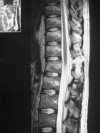Residual mobility of instrumented and non-fused segments in thoracolumbar spine fractures
- PMID: 16601974
- PMCID: PMC3489432
- DOI: 10.1007/s00586-005-0939-x
Residual mobility of instrumented and non-fused segments in thoracolumbar spine fractures
Abstract
The surgical management of thoracolumbar fractures presents potential benefits. However, the surgery solve the instability by fusion of mobile segments. We incorporate in our treatment algorithms, the use of restricted arthrodesis at injured levels, regardless of longer instrumentations, as well as the use of non-fused transitory stabilizations, based on the conviction that in non-fused segments without traumatic disc injury, mobility persists once the instrumentation is removed. The goals of this study were to compare the mobility of non-fused segments after hardware removal to a normal range of motion and to find prognostic pre-op imaging patterns. We reviewed 21 consecutive patients who underwent surgery with preservation of mobile segments (non-fused segments included in the construction) in order to recover mobility after removal of instrumentation, performed between 1995 and 2001. All patients were treated by indirect reduction with posterior transpedicular instrumentation. Clinical and radiological outcome was analyzed after an average follow-up of 46.6 months. Satisfactory subjective outcome results were obtained in 94.7%. The dynamic radiological follow-up study showed 75% (21 segments) with normal or decreased range of motion (ROM) and 25% (7 segments) without mobility. The non-fused segments with hardware removal before 10 months of evolution presented a normal or decreased mobility in 83.2% while the segments with hardware removal after 10 months showed 68.8% of mobility. The intervertebral disc (IVD)'s with normal initial MRI morphology preserved their mobility in 81.9%. Complications occurred in four patients: two superficial wound infections and two patients presented a late fracture of one USS Schanz. The results of this study prove that in thoracolumbar fractures, non-fused spinal segments included in pedicular instrumentation maintained mobility in a high percentage once the hardware is removed. 75% of the segments presented a normal or decreased ROM.
Figures







Similar articles
-
Surgical outcomes of temporary short-segment instrumentation without augmentation for thoracolumbar burst fractures.Injury. 2016 Jun;47(6):1337-44. doi: 10.1016/j.injury.2016.03.003. Epub 2016 Mar 12. Injury. 2016. PMID: 26994520
-
Spinal fracture reduction with a minimal-invasive transpedicular Schanz Screw system: clinical and radiological one-year follow-up.Injury. 2015 Oct;46 Suppl 4:S75-82. doi: 10.1016/S0020-1383(15)30022-X. Injury. 2015. PMID: 26542870
-
Short-segment fixation without fusion for thoracolumbar burst fractures with neurological deficit can preserve thoracolumbar motion without resulting in post-traumatic disc degeneration: a 10-year follow-up study.Spine (Phila Pa 1976). 2013 Aug 1;38(17):1482-90. doi: 10.1097/BRS.0b013e318297bdb7. Spine (Phila Pa 1976). 2013. PMID: 23615381
-
Successful short-segment instrumentation and fusion for thoracolumbar spine fractures: a consecutive 41/2-year series.Spine (Phila Pa 1976). 2000 May 1;25(9):1157-70. doi: 10.1097/00007632-200005010-00018. Spine (Phila Pa 1976). 2000. PMID: 10788862 Review.
-
Congress of Neurological Surgeons Systematic Review and Evidence-Based Guidelines on the Evaluation and Treatment of Patients With Thoracolumbar Spine Trauma: Novel Surgical Strategies.Neurosurgery. 2019 Jan 1;84(1):E59-E62. doi: 10.1093/neuros/nyy364. Neurosurgery. 2019. PMID: 30299485
Cited by
-
Impact of Sagittal Balance on Clinical Outcomes in Surgically Treated T12 and L1 Burst Fractures: Analysis of Long-Term Outcomes after Posterior-Only and Combined Posteroanterior Treatment.Biomed Res Int. 2017;2017:1568258. doi: 10.1155/2017/1568258. Epub 2017 Jan 10. Biomed Res Int. 2017. PMID: 28164114 Free PMC article.
-
Long-Segment Versus Short-Segment Pedicle Screw Fixation Including Fractured Vertebrae for the Management of Unstable Thoracolumbar Burst Fractures.Cureus. 2023 Feb 20;15(2):e35235. doi: 10.7759/cureus.35235. eCollection 2023 Feb. Cureus. 2023. PMID: 36825073 Free PMC article.
-
Treatment of thoracic or lumbar burst fractures with Balloon Assisted Endplate Reduction using Tricalcium Phosphate cement: histological and radiological evaluation.BMC Musculoskelet Disord. 2017 Oct 10;18(1):411. doi: 10.1186/s12891-017-1770-3. BMC Musculoskelet Disord. 2017. PMID: 29017495 Free PMC article. Clinical Trial.
-
Long-term investigation of nonsurgical treatment for thoracolumbar and lumbar burst fractures: an outcome analysis in sight of spinopelvic balance.Eur Spine J. 2008 Aug;17(8):1073-95. doi: 10.1007/s00586-008-0700-3. Epub 2008 Jun 25. Eur Spine J. 2008. PMID: 18575898 Free PMC article.
-
Thoracic spine fractures: injury profile and outcomes of a surgically treated cohort.Eur Spine J. 2011 Sep;20(9):1427-33. doi: 10.1007/s00586-011-1698-5. Epub 2011 Jan 28. Eur Spine J. 2011. PMID: 21274728 Free PMC article.
References
-
- Aebi M, Etter C, Thalgott J. Stabilization of the lower thoracic and lumbar spine with the internal spinal skeletal fixation system. Indications, technique and first results of treatment. Spine. 1987;12:544–551. - PubMed
-
- Akbarnia BA, Crandall DG, Burkus K, Matthewa T. Use of long rods and a short arthrodesis for burst fractures of the thoracolumbar spine. J Bone Joint Surg. 1994;76-A:1629–1635. - PubMed
-
- Armstrong GW, Johnston DH. Stabilization of spinal injuries using Harrington instrumentation. J Bone Joint Surg. 1974;56-B:590.
MeSH terms
LinkOut - more resources
Full Text Sources
Medical
Miscellaneous

